
This territory is irrigated by the La Leche River, a dry river that is activated during the seasonal rainy season of the neighboring mountains, does not flow into the sea and naturally irrigates the largest desert in Peru. This channel is also activated cyclically by the rains caused by the El Niño Phenomenon, filling the valley with fertile sediments used by an agriculture that maintains ancestral crops from an irrigation system that still preserves pre-Hispanic channels. This territory preserves two large settlements characterized by monumental truncated pyramids shaped adobe constructions, which house very rich funerary contexts, scientifically investigated, surrounded by an ecosystem of equatorial dry forest, which houses various species of flora and fauna, some endemic or threatened by climate change and anthropic effects.
The Mochica culture is considered one of the most important that developed on the north coast of Peru and it is perhaps the pre-Inca culture that we know the most aspects of due to its multiple and magnificent ceramics, in which a true catalog can be found. of the daily life of the Moche people. This kingdom developed approximately between the III century B.C. and VI AD within the Early Horizon period, its main range was in the valleys of Trujillo and Lambayeque. Its unique development of the power of the Moche Valley, which managed to organize a state of conquest that subdued those of Virú and other valleys, both to the north and to the south, forming a kingdom that spanned from Lambayeque to Nepeña, with extensions to Piura, to the north, and Huarmey to the south.
Moche society was stratified. Social classes were basically reduced to two: leaders and people. The economy was mainly based on agriculture and trade; hunting, fishing and gathering were complements. There are graphic testimonies about the Moche religious ideology, its rites and its priesthood. A magical-religious being appears as the central figure of the highest hierarchy, he is easily identified by his tiger-toothed mouth with fangs and by his large semi-lunar headdress.

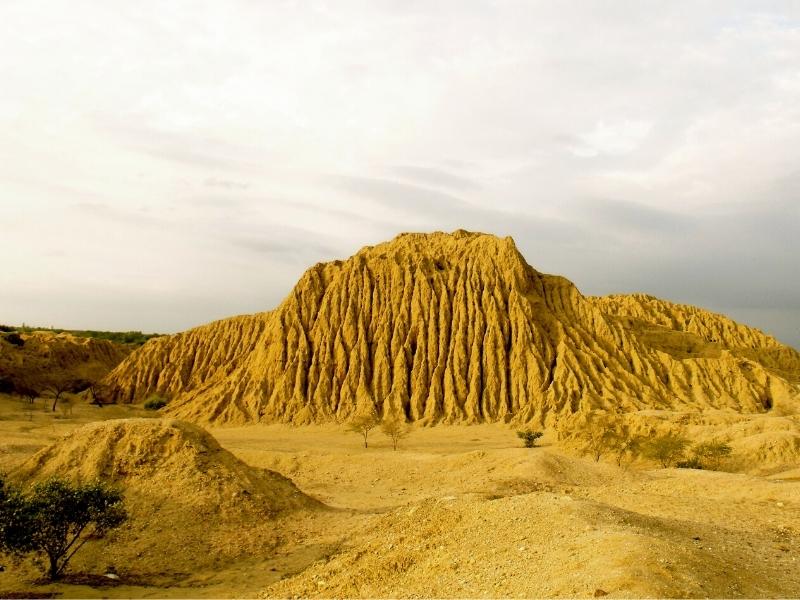
The Túcume pyramids are notable for their extraordinary size: according to estimates, more than 130 million sun-dried adobe bricks were needed to build the largest one, which is 450m long, 100m wide and 40m high.
According to myths and legends, each step represented a phase of development in human life, which had to be fully and integrally enjoyed. The ascent was painful and when reaching the top, a high spirit was achieved and the ceremony at that time was a festive event in the lives of those human beings.
Unlike those of Egypt, the pyramids of South and Central America did not have points, but they did have large platforms where the temples were located. The Pyramids of Túcume belonging to pre-Hispanic Peru, generate fascination and mystery. In other words, the inhabitants of pre-Hispanic Lambayeque founded a mythical society that had a great relationship with the natural pre-existences, hills, sea, dry forests; and, precisely, these pre-existences generated myths that give life to monumental architecture.
There are nearly 26 pyramids and platforms above this valley. It is estimated that more than 130 million sun-dried adobe bricks were used to build the largest pyramid which is 450m long, 100m wide and 40m high. The pyramids are believed to have been built between 1000-1500 BC.
In Túcume we find pyramids that were the residences of the elite of the Lambayecan culture. They are connected through internal paths with other spaces such as cemeteries, sacred temples and living space.

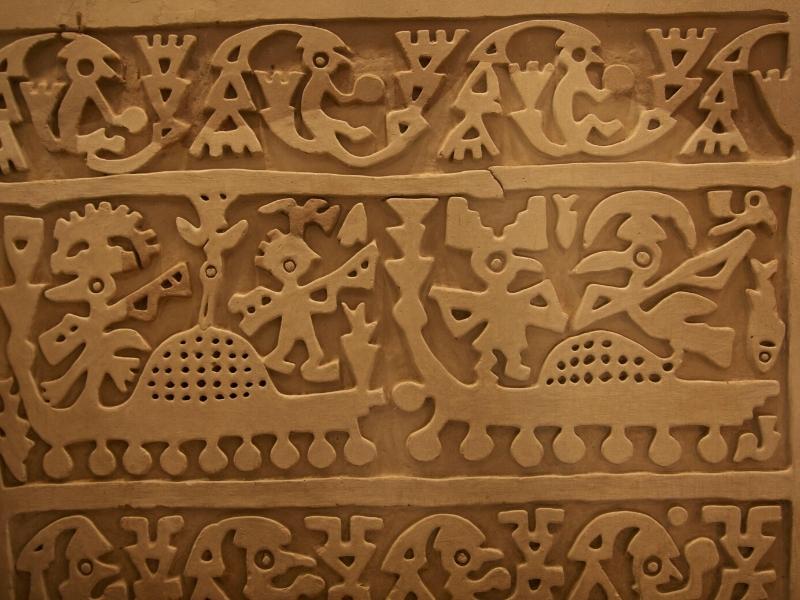
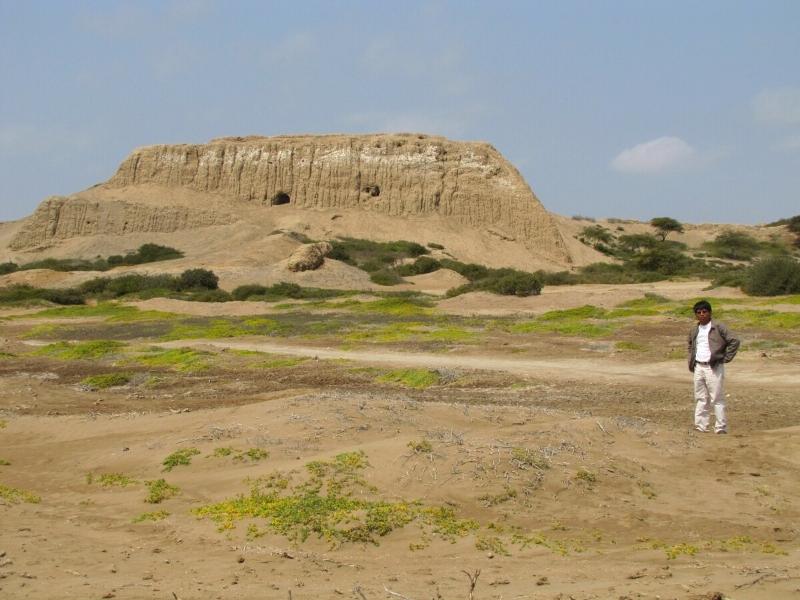
Eight km. from the city of Lambayeque, in the district and province of the same name, there is an impressive archaeological complex that covers 95 hectares belonging to the culture of the same name, which since the eighties, and especially since 2006, is object of archaeological excavations, as well as ethnographic and ethnohistorical investigations whose main objective is to find the possible relationship between the archaeological evidence and the oral legend that narrates the existence of the dynasty founded by Naylamp.
In 2011, archaeologists discovered in a mound of sand, a few meters south of the Chornancap pyramid, evidence of temples, plazas, habitation sites, and some burials. One of the tombs, dated between the 12th and 13th centuries AD, was that of a woman whose grave goods revealed her importance in the political and religious structure of the Lambayeque culture. The main structure of the complex, the Huaca Chotuna is a monumental log building.

In the Chotuna-Chornancap archaeological site, two pyramids stand out, built in unfired adobe bricks by the people of the Lambayeque period, 800 – 1350 A.D.: the Chotuna pyramid, 40 m high, with a ramp that first faces it and then the surrounds, and the Chornancap pyramid, 1.5 km to the west, lower and with a direct ramp connecting its three levels. Both are truncated pyramids: the upper square was used for ceremonies.
Next to the pyramids are ancient constructions with adobe walls. Some served as workshops for the work of artisans and others were places of residence and functions of the elite. There are also housing sites and cemeteries for farmers, artisans and merchants.
In 2009, archaeologists from the Brüning Museum expanded the excavation and revealed an enclosure with a platform at one end and a throne-like seat with a back. To the south of the Chornancap pyramid is located a set of temples, plazas, habitation sites and burials, known as the elite residence. In it two altars stand out, one with cylindrical wooden columns and the other, the main one, with square section columns, connected by a labyrinthine passageway.
Between the two altars, archaeologists in 2011 found a stain on the floor. When excavating, they initially found ceramic offerings of the late Lambayeque (1100 – 1350 AD) and coastal Cajamarca types, which announced the presence of something transcendental in the place.

A relatively small truncated pyramid, located in the central part of the complex, is the one that deserves a special mention because in the northwest corner there is a temple that contains a series of reliefs. The area has a patio of approximately 30 m. x 16m whose internal walls were ornamented with friezes in relief painted in yellow.
The patio was associated with a bench that is accessed by a central ramp, also ornamented with reliefs, and from there to a step that leads to the threshold of an opening in the center of the south wall.
The heads of these double-headed snakes are associated with the headdress of a schematic character, on each side it seems that the snake bit the character’s head; In the inner center of the two-headed snake, two animals appear face to face as if they were squirrels, in the environment and to complete the scene appear fish, birds and snakes.
The bench to which we have referred next to the patio of the Temple of the Friezes, would be covered, the remains of the pillars that would support the coverage have been found. These pillars, which would have been six, were built with a carob tree trunk used as a right foot to which a rope had been wound to which the mud cake was adhered to give it a quadrangular shape.
Of the pillars found, two lack decoration and the other two are ornamented on their four fronts, with the representation of the mythical bird in a dive catching a fish and various anthropomorphic and zoomorphic figures. The other two pillars would have been destroyed by looters.
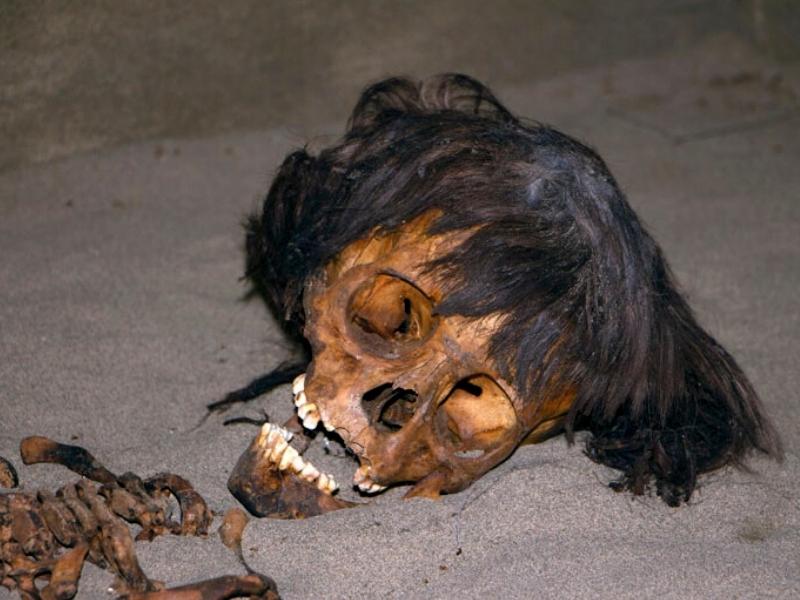
Located at 240 m. northeast of Huaca Chotuna, formerly called Huaca Norte because it is located in the northern end of the complex. The place has two levels, the first in the shape of a pyramidal trunk and the second in the shape of a U open to the west. Several construction moments have been identified in the building from the mid-late Lambayeque period to the Chimú-Inca occupation. It is in this last phase that the three areas with multiple burials are associated. In total 33 burials of individuals of various ages who were sacrificed. The interpretations carried out by archaeologists imply the possibility of offerings of blood, heart and body as food to the ancestors and to the huaca.
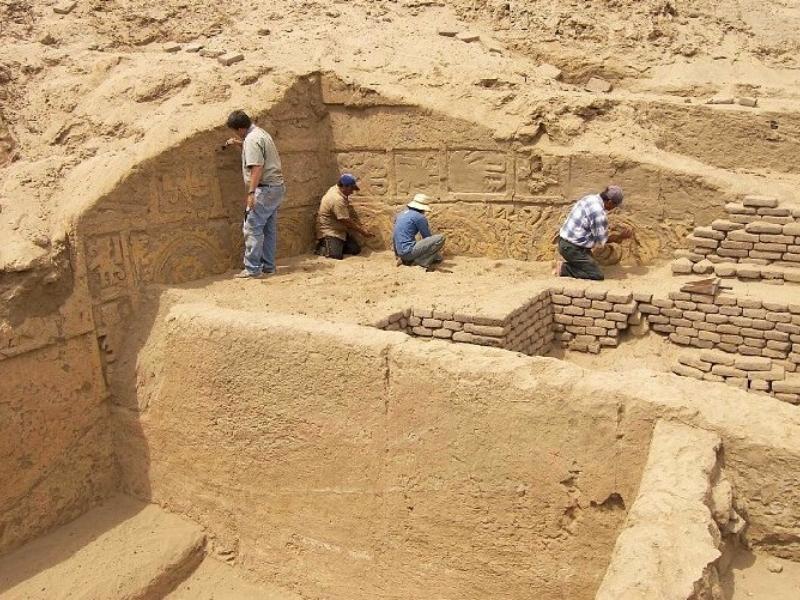
Approximately 220 meters to the north of the Huaca Chotuna, the temple is built in four phases with continuous remodeling in each of them. The name responds to the motif that adorns one of the platforms that represents a symbol of the Lambayeque culture: the anthropomorphic wave. This motif, which has its antecedents in the Moche culture, appears profusely represented in textiles, ceramics, copper, gold and silver accessories, as well as on the walls of some Sicán buildings.
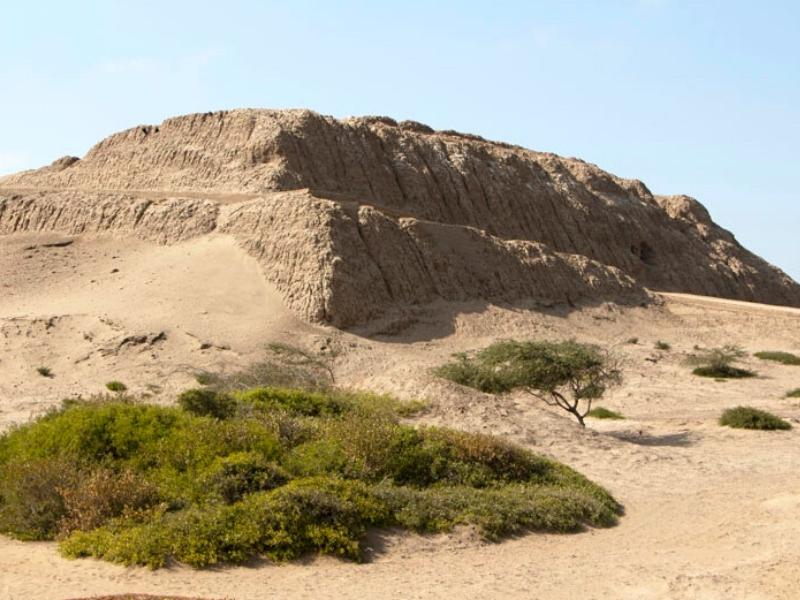
With a rectangular floor plan, it has three levels of platforms connected by a central ramp, it would have covered an area of 17 ha. and 25m. The different levels of superimposed constructions suggest a long period of occupation with multiple reconstructions. The excavation campaigns made it possible to interpret the different periods of construction and remodeling in Chornancap, discovering in 1982 -during the work of Christopher Donnan- a patio with polychrome mural painting that would correspond to the intermediate phase of the occupation between 1100 and 1300 AD.
The murals located in the upper part, approximately 2.65 m. from the floor to the white walls, they represent a series of characters associated with trophy heads. The colors used were: red, yellow, dark green, light green, white and black, all of them the product of mineral pigments. The dating of these paintings corresponds to 1100 and 1300 AD.
To the west of the courtyard of the murals described above, there is an area of great architectural quality in which there is a square with a trapezoidal floor plan from which, accessed by a ramp, one reaches a low platform with two benches located to the east and West.
Towards the front, in the center of a longitudinal bench, a structure has been arranged in the form of a throne, an area that had a roof through the holes found, the same ones that must have contained the posts. This area has been called the Sacred Throne of Chornancap.
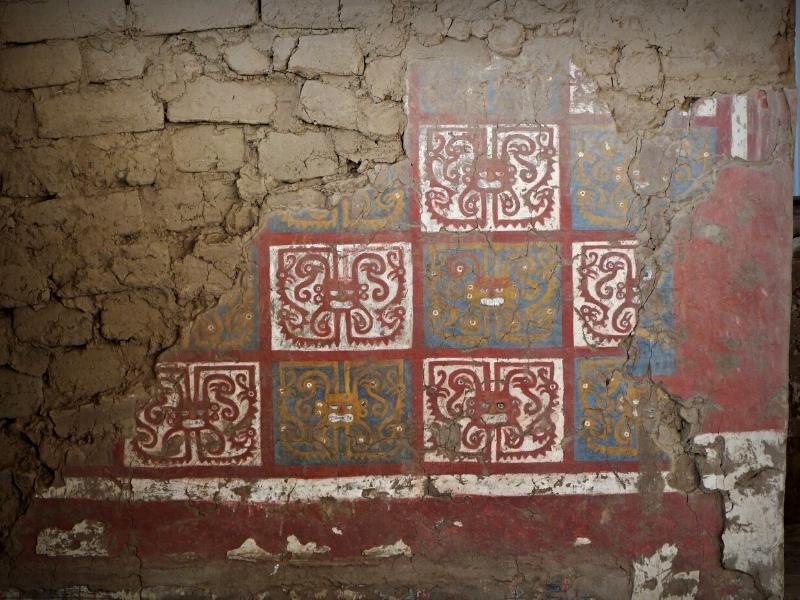
In front of each of the side benches there are small quadrangular cubicles distributed symmetrically, 17 on each side and one in front of the throne, making a total of 35 structures. On both sides of the access to the platform there are two structures in the form of podiums in which the shape of the staggered symbol stands out, which gives greater symbolism to the place and towards the sides of the platform, behind each bench, there are some narrow corridors with restricted access. Towards the southeast there is a small enclosure that must have had some cult function related to the plaza with the throne. This space was roofed, the carob columns have been found plastered and painted red.
93 meters south of Chornancap, a structure was found that, when excavated, uncovered a series of deposits, enclosures, ramps, open spaces and the remains of pillars of what archaeologists say would correspond to an Elite Residence. This area has two sectors defined and separated by a wall: the ritual and residential sector to the north and the domestic sector to the south.
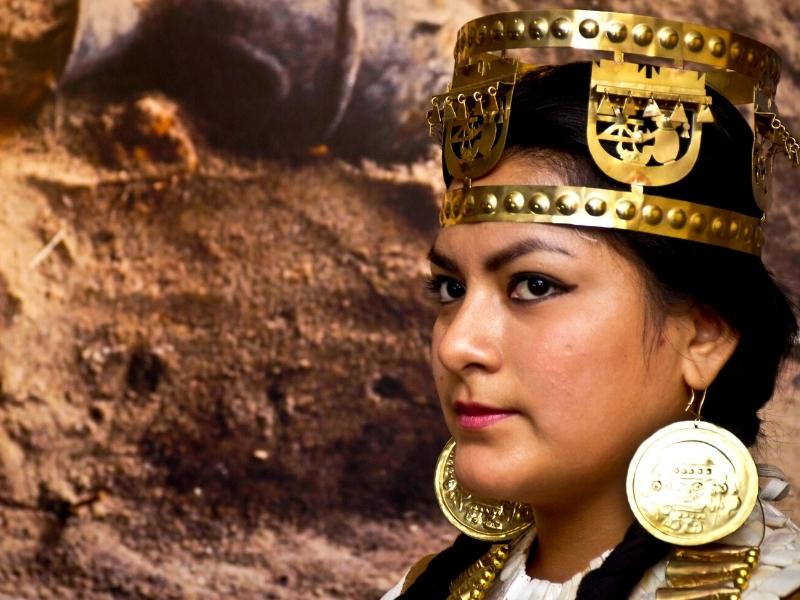
In the ceremonial area of this structure, the female character of the highest Lambayeque hierarchy was found in October 2011. Under a group of ceramics of very fine elaboration and finish, typical of the coastal Cajamarca style and others of the Late Lambayeque period, two mantles painted with the motif of the anthropomorphic wave were found, in whose center 90 copper discs of 12.5 cm were sewn. diameter. Upon removing these cloaks, an ovoid structure was found whose mud floor registered the footprints of human footprints of 3 or 4 people as if it were a dance associated with the closure of the tomb. at 60cm deep was found the funerary bundle of a female character of the highest status and hierarchy of the Lambayeque culture, buried with a rich funerary trousseau composed of ceramic pieces, a gold ceremonial cane, Spondyllus shell pectorals, turquoise beads, of Conus and Strombus shells, a silver-plated copper mask, gold and silver earmuffs, a gold crown, as well as necklaces of discs, bracelets of spherical pieces of gold and gold and silver vessels, all of them with very elaborate iconographic motifs. This funerary trousseau corresponds to who would have been the female character of the highest status, the highest political and religious authority in Lambayeque.

Under the tomb of the priestess of Chornancap, in 2012 the team of archaeologists discovered a new grave which they called the tomb of the character of spomdylus who must also have played a hierarchical role given the rich grave goods that accompanied him with concentrations of this mollusk in both sides of the head and one on each hand. What is particular about this burial is that it was prepared to remain flooded by underground water for 8 centuries, and must have had some special meaning in relation to the extraction of the Spondylus in the depths of the sea. Unlike the priestess, who was buried sitting facing east, the character is in supine position facing west. It is a man between 30 and 40 years old with a funerary trousseau with earmuffs, headdress, ceramics representing Spondylus and the knives used for fishing, accompanied by two individuals who also carried the precious mollusk. The overlapping of the tomb of the priestess and the character of the spondylus, burials carried out at two different times, raises the question of the possible relationship between them, or between their companions.
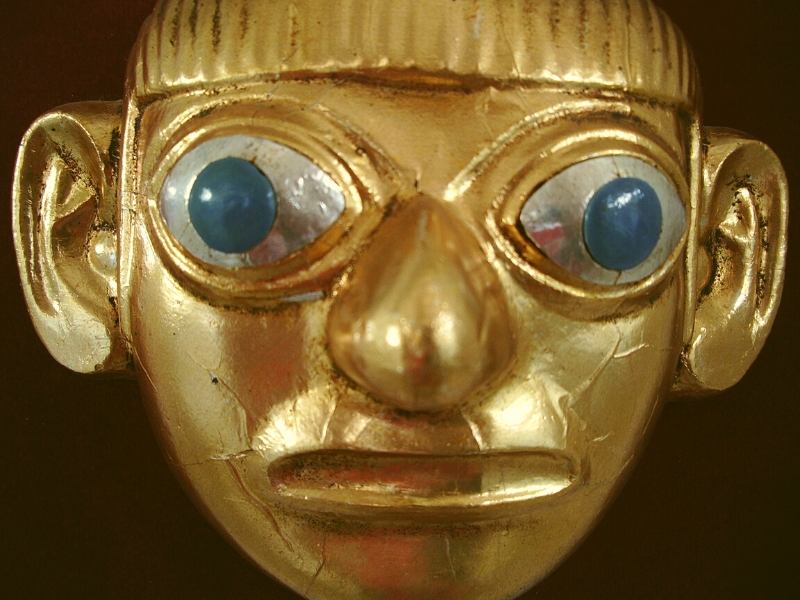
The archaeological sanctuary of Sipán, commonly known as “Huaca Rajada”, consists of two large pyramidal structures of adobe aligned from west to east.
Next to these artificial mountains of mud and surrounded by the green color of sugar cane stands a rectangular platform with three levels (Figure 1). The largest occupies a rectangular area of 130 square meters and the smallest 50. Inside, the burial chamber of the Lord of Sipán was housed, the most remarkable archaeological find in the northern Peruvian Andes, since they are helping researchers to formulate a clearest and most exact reconstruction of the civilizations of ancient Peru.
These great pyramids, which were enlarged successively, required a large amount of labor and land to create the adobe bricks necessary for construction. Probably, it was extracted from the lagoon that is located to the south of the sanctuary. In addition to these pyramidal structures, there is a rectangular platform, located to the east, which occupies an area of 130 by 50 square meters, in which the burial chamber of the Lord of Sipán was discovered. Between this and the first of the pyramids there is a large plaza. Right now, despite working on it, it is difficult to know exactly the limits of the complex that could perhaps extend under the current cane fields.

During the year 1987, a time of hardship, many peasants searched for gold and precious metals in Huaca Rajada under the adobe bricks of the old Mochica buildings. These poachers are known in the region as “huaqueros” and, at the same time, the archaeologist Walter Alva and his team tried to carry out their research work, with scientific criteria. Bearing in mind that the reason for interest was the same, the relations between the archaeologists and the settlers were very complicated, since many of them dedicated themselves to looting (huaquear) the tombs.
Walter Alva y Alva confronted them from the beginning and managed to increase the police presence in the area, but this increased the tension and much more when the death of Ernil Bernal, a member of one of the best-known looters’ gangs, occurred. the region.
In these circumstances the excavations are about to be suspended on several occasions. Meanwhile, looters (huaqueros) desecrated a rich tomb. Fortunately, the police seized part of the objects looted at the home of one of the thieves. Among them was a gleaming, naturalistic gold human head with silver-set eyes and 5-inch-high lapis lazuli blue pupils.

This beautiful effigy with a pronounced nose was reminiscent of the famous “portrait heads” of the ceramics of the Moche culture. Two large, expressive gilt-copper puma or jaguar faces displayed their ferocious stance with retracted mouths and sharp, 16cm-diameter red-shell fangs.
Among others, of the total of thirty-three objects seized by the police from looters, there were also two perfect representations of peanuts in gold of up to 9 cm. long (three or four times natural size), elongated flaps of the same metal imitating shell cutouts, necklace beads and other gilt copper and silver objects.
This police recovery was the most important in many years given the artistic quality and perfection in the metallurgical technique of the pieces. However, it also seemed clear that these pieces were part of a larger treasure, which was still hidden. Only a burial of a great character could offer artifacts of such perfect goldsmithing.
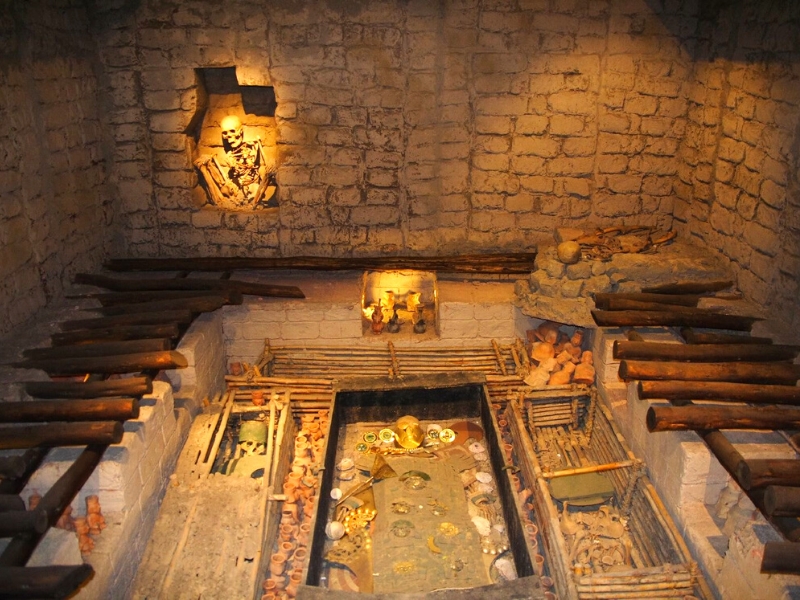
A few months later, Walter Alva and his team located on the platform the skeleton of a young man who carried a shield on his left forearm and whose feet had been amputated. He was a kind of guardian soldier strategically placed to guard a tomb and the definitive sign of what would be the most important discovery of Peruvian archeology in recent decades.
Walter Alva y Alva notes the following: “just a few centimeters deeper, there was an underground chamber of 25 square meters protected by seventeen transversal beams of carob wood that extended the length of the chamber from east to west. When the beams were removed, a sealed sarcophagus 2.20 meters long x 1.25 meters wide was discovered. When removing the boards that closed the sarcophagus, three large textiles were found that wrapped a body.
Inside, lay the remains of a man whom the archaeologists decided to call “Lord of Sipán” in allusion to the concept of lordship as a sociopolitical organization of the North Coast and to the place of the discovery. Let us remember that “Siec” means Lord in the Mochica language and Sipán could derive from “Si-pang” or “Siec-Pan” (“House of the Lords”).
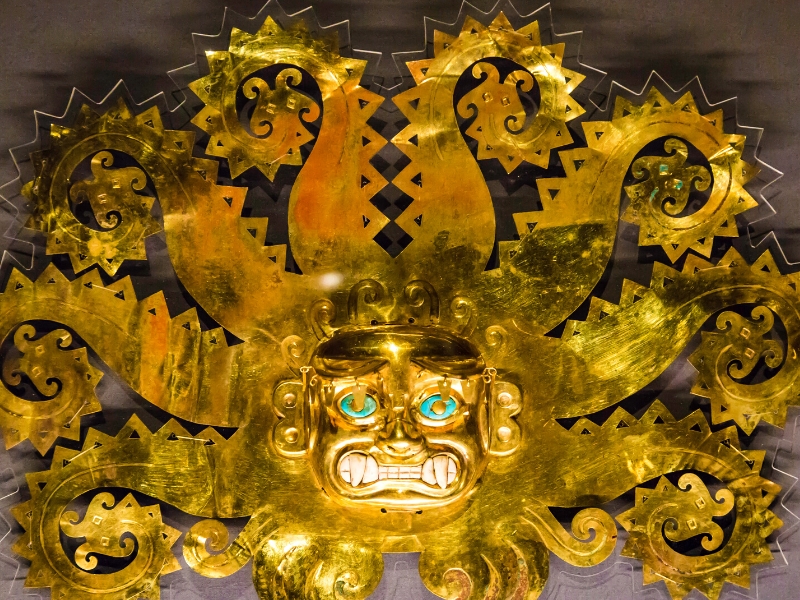
Walter Alva adds: “more than 600 objects were found in his tomb. One of the first findings arose when a mud concretion was removed at the bottom of an empty space, at which time a perfect and tiny face appeared. It was the central human figure of a gold earmuff, without a doubt the most beautiful and delicate art object of the set and, probably, the best example of Mochica gold work known to date.
The riches and honors with which this character was buried demonstrated the importance that his figure reached during his mandate. The lord’s clothing wore turquoise and a gold crown. His eye sockets had been filled with two replicas of his eyes in gold. His chin was protected by a mask, also in gold, and his nose by a nose ring of the same precious metal. His chest had eleven pectorals with colored shells, turquoise bracelets, a gold ingot in his right hand (the Sun) and a silver one in the left (the Moon). Beside him a scepter topped with a gold pyramid, and finally a necklace with 72 gold spheres. But the greatest treasure found was a crown 62.7 centimeters wide and 42 centimeters high, also made of gold, that appeared under the body of the Lord of Sipán and that only appears in the Mochica iconography related to the characters of the highest investiture that hoard honors and offerings. .
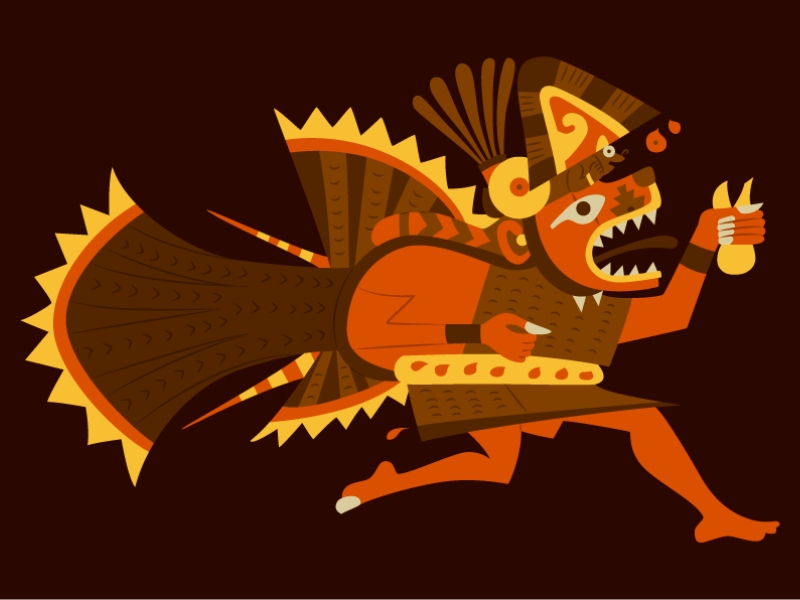
The data obtained in “Huaca Rajada” constitute an important key to the knowledge of the Mochica culture and demonstrate the amount of information that a scientifically excavated tomb can give, without a doubt, much more than hundreds of pieces removed from their context and exposed in different museum collections. With this finding, the knowledge and interpretation of the Mochica culture changed. The magnificent ornaments, emblems and costumes found were key to understanding the context in which this civilization lived, and to revisiting its technological development as well as its social, political and religious structures. And especially, in how the landscape was handled.
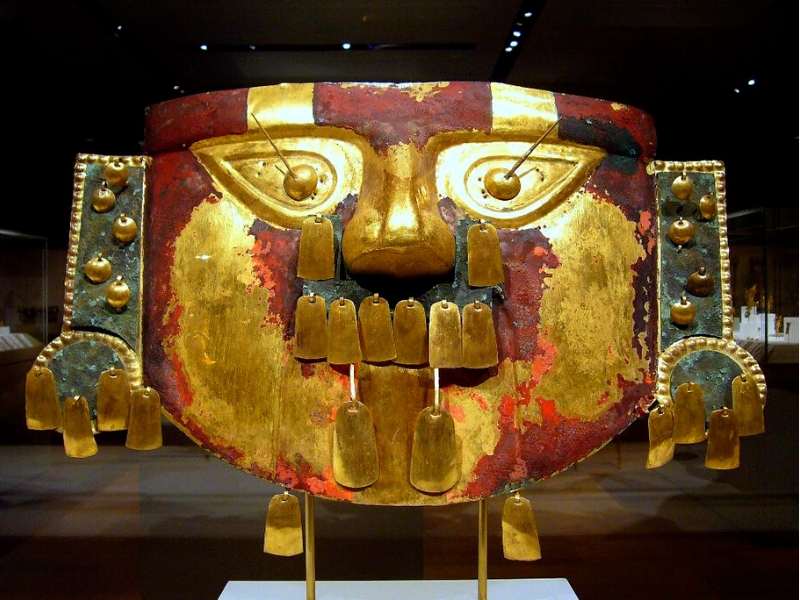
The north of Peru was the cradle of some of the most important cultures of Peru. They left behind impressive constructions that summarize their high degree of architectural development and the impressive organization of their societies. Within these cultures, the legacy of the Sicán culture is especially important, whose archaeological complex continues to throw new discoveries into the world today.
This archaeological complex is located within the Pómac Forest Historic Sanctuary (Lambayeque). It is made up of various pyramidal structures built between the 8th and 12th centuries of our era, which would have functioned as temples, houses, cemeteries and craft workshops. Among these constructions, the Huaca “La Ventana” stands out, in which beautiful works made of metal were found, such as the gold Tumi or ceremonial knife.

Set of 20 clay pyramids distributed in an area of 46 km2, within the Batán Grande hacienda. It includes the huacas Botija, Colorada, Horno de los Ingenieros, Huaca Loro, La Merced, El Santillo, Las Abejas, La Ventana, Rodillona, La Facho, Cholope, Arena, Corte, among others, the same ones that rise in the middle of carob trees . It is believed that it was the center of development of the Lambayeque or Sicán Culture (muchik word that means “house or temple of the moon”.
The Sicán Culture came to dominate most of the northern Peruvian coast at the time of its peak. Its inhabitants were skillful goldsmiths who created highly elaborate pieces in various metals such as gold, arsenical copper (copper and arsenic alloy) and tumbaga (low carat gold, silver, copper and arsenic alloy). They also stood out as ceramic craftsmen.
A large number of these pieces can be seen at the Sicán National Museum, one of the most modern in the country, which is located in Ferreñafe and where visitors can appreciate an impressive recreation of the customs and ways of life of this culture.
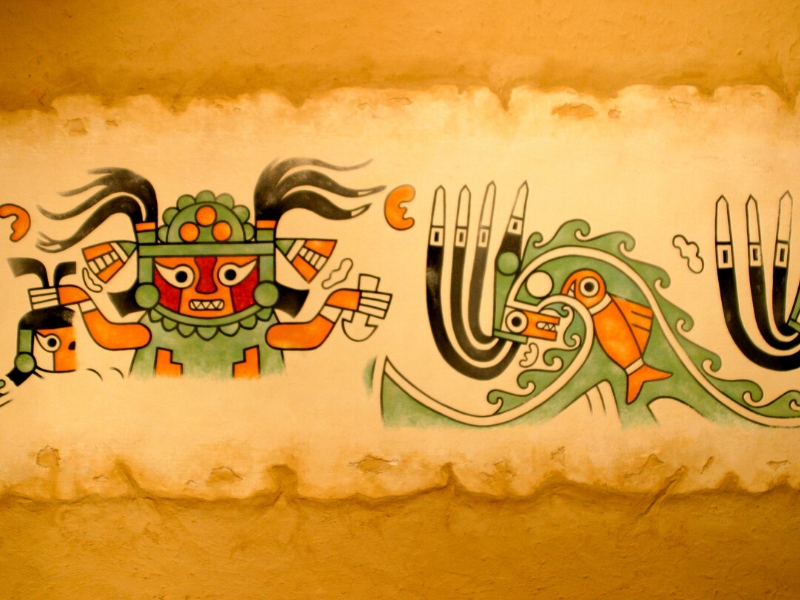
The huaca known as Huaca El Oro, is a pyramid of 35 meters. of 100 meters side, it presents a zigzag ramp, with a platform to the north of 300 meters. long, made with the chamber and stuffing technique. At its northeast and southeast base, the tomb of a character from the Sicán nobility was excavated, which is accompanied by an important trousseau of gold objects and is currently exhibited in the Sicán National Museum.
It was excavated during October 1991 and March 1992. It measures approximately 80 meters per side at its base and reaches more than 35 meters in height. The excavation of the East Tomb allowed us to find a great character buried 12 meters deep. Around the burial chamber there were 7 niches located on its four sides. The floors of the niches were covered with sheets of “tumbaga” (copper and gold alloy or copper, gold and silver). A total of 300 kg were found. of tumbaga, 2 silver alloy tumis (ceremonial knives), 6 tumbaga masks, necklaces of sodalite, amber, spondylus, amethyst and quartz. Also, 20,000 copper arsenical playing cards were found.
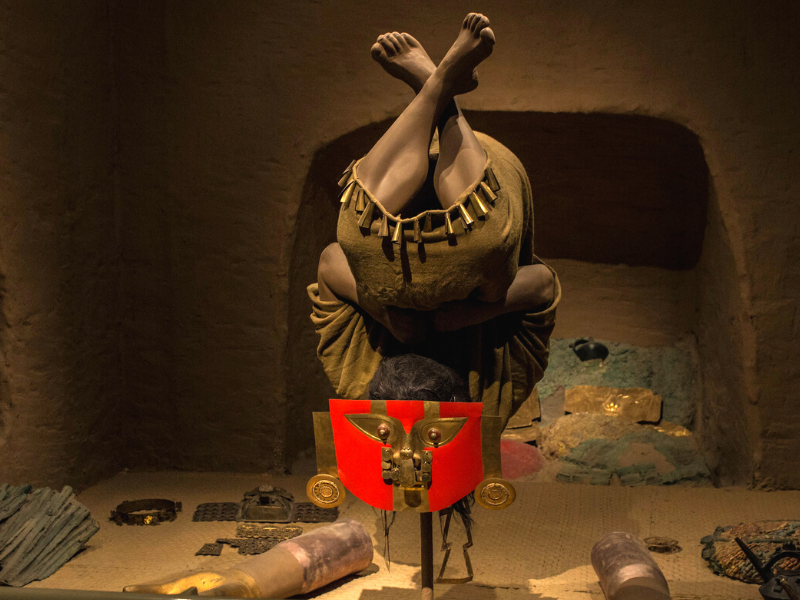
The main person was found with his body in an inverted position, his face facing west. He was between 40 and 45 years old and his height was approximately 1.60 cm. His body was covered with cinnabar (mercuric sulfide). His skull was flattened, possibly because as a child he was subjected to a deformation process using a flat board. He was not left-handed, however the cup he was buried with was placed in his left hand. His head was separated from his body and placed in a turn of about 180º, a mask worked in 14-karat gold, in a single sheet (52% gold, 31% silver and 17% copper) was placed on his face. ).
Other jewels of the Lord were: two gold calves, six pairs of gold earmuffs, an ornament as a headdress with the representation of the head of a bat and two gold alloy nose rings.
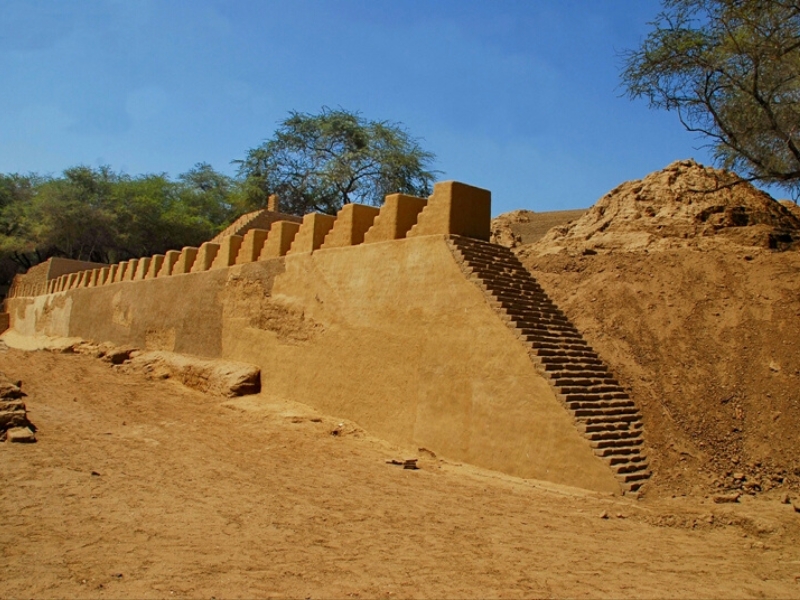
Las Ventanas has an artificial platform full of tombs that were mausoleums of the main characters of the Sica dynasty, and of people who were related to them.
The department of Lambayeque has as one of its tourist attractions, the Pómac Forest Historic Sanctuary, located in the middle part of the La Leche Valley. Specifically in the area of the former paddock of the Batán Grande hacienda, northeast of the city of Chiclayo.
Regarding the Huaca Las Ventanas, it was an intensely looted area between the years of 1920 and 1969 and from this pyramid the gold Tumi symbol of Lambayeque was recovered. On the other hand, mural paintings with beautiful designs alluding to the sea have been recovered from this huaca and are reproduced in one of the rooms of the Sican museum.
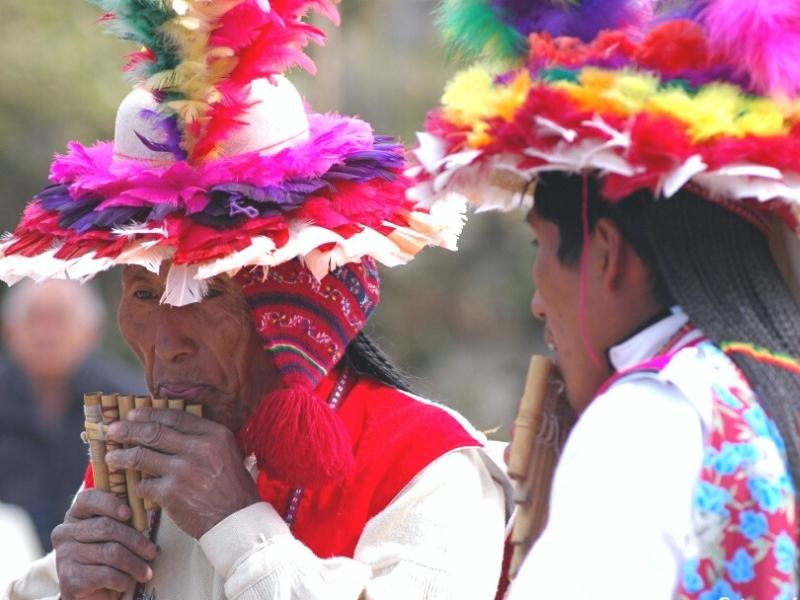
Sublime landscapes, wildlife, history, culture - Peru has more than its fair share. Its famed snow-capped Andean peaks shelter the temples and fortresses of the Inca and other pre-Columbian cultures, linked by a network of paved trails.

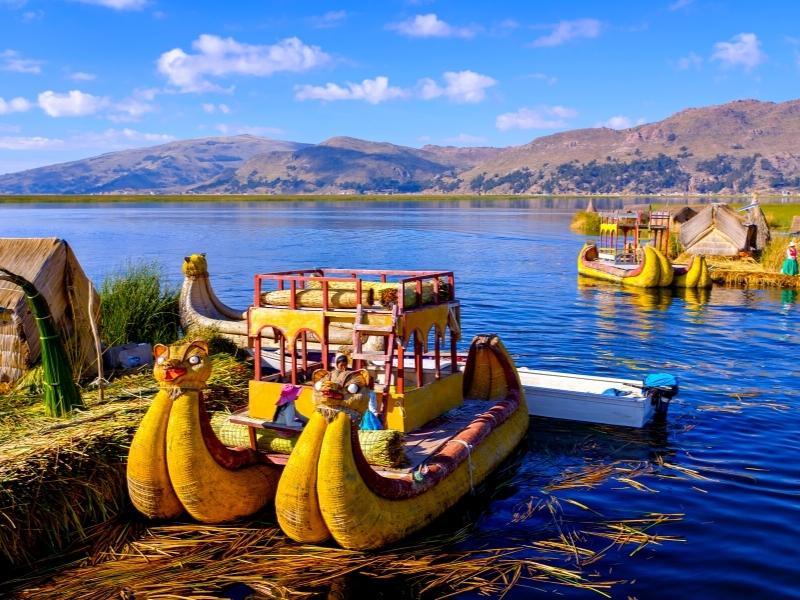
The wonders of Peru await you as you hike through the Manu Amazon rainforest, traverse the plains of the Sacred Valley of the Incas, and stroll the cobbled streets of Cusco on this 15-day trip from Lima. Search for monkeys and medicinal plants in the Amazon, travel the ancient road to Machu Picchu, experience a stay in a traditional community on the shores of serene Lake Titicaca.

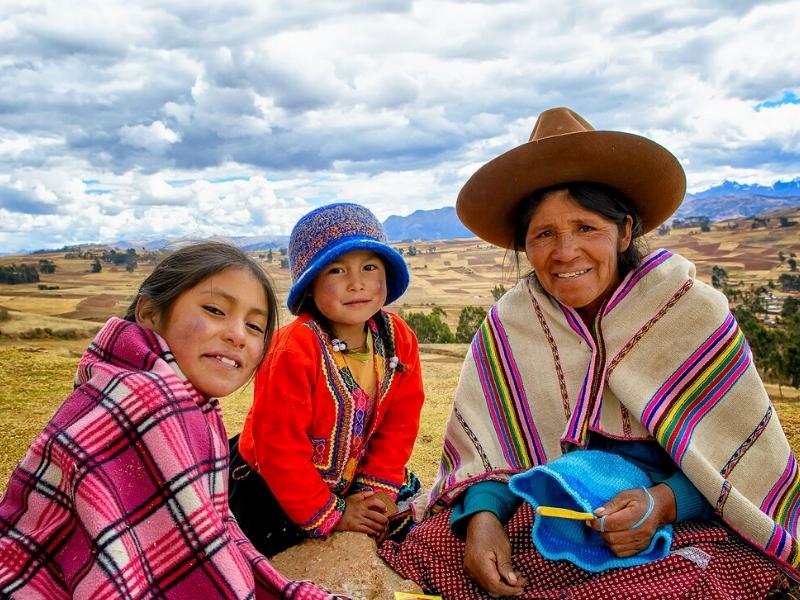
The top sights of Peru will leave all the family thrilled by the scenic grandeur, ruined temples, colonial cities, amazing inca trail to Machu Picchu, the Inca Lost City, once buried under the tropical forest which surrounds it.


Dive deep into the culture and landscapes of Peru with this adventure to Machu Picchu, the Amazon and more. Search for wildlife along jungle trails and rivers in the rainforest from a comfortable lodge then head up into the Andes to Cusco, the capital of the Inca empire.

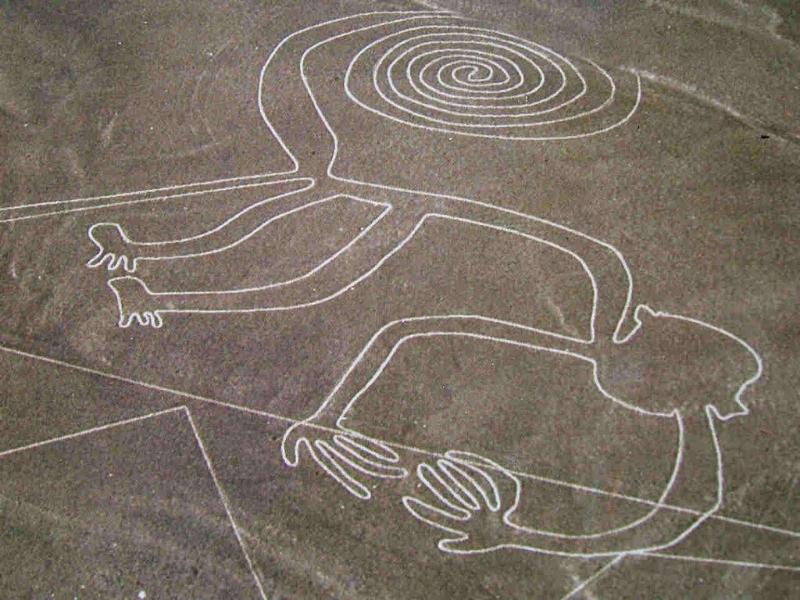
Visit Peru and discover its highlights from Lima to Cusco on an exciting journey that encompasses modern cities and ancient worlds. From the depths of the Colca canyon to the heights of the Andes and on to the unique islands of Lake Titicaca, be immersed in fascinating Peruvian culture while discovering its history buried deep within the walls of lost cities.


Colours of Peru calls to you with all the allure of the ancient and the mysterious. From the soaring peaks of the Andes to the lush Amazon Rainforest, from the pre-Colombian ruins in the mountains to the Spanish colonial mansions on the coast, 14 Days in Peru offers you exciting adventures and unique experiences.
